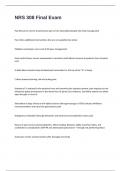NRS 308 Final Exam
Pain Resources correct answersAcute pain service (specialized people who help manage pain)
Pain clinics (additional interventions that are not available else where
Palliative and Hospice care ( end of life pain management)
Gate control theory correct answerspain is carried by small afferent neurons to posterior horn of spinal
cord
A-delta fibers transmit sharp localized pain (remember b/c the top of the "A" is sharp)
C fibers transmit burning, dull and aching pain
Substance P is released in the posterior horn and transmits pain impulses upward, pain impulses can be
blocked by gating mechanisms in the dorsal horn of spinal cord, thalamus, and limbic system (can either
open the gate or close it)
Stimulation of large (A-beta and A-alpha) neurons (through massage or TENS) releases inhibitory
neurotransmitters and closes the gate (lowers pain)
Endogenous endorphin (through distraction and exercise) and encephalins reduce pain
Nature of pain correct answerssubjective, affects healing, behavior, ability to perform ADLs, and
contributes to complications (DVT/PE and atelecatasis/pneumonia--> through not performing ADLs)
Acute pain correct answersresolves after damaged area heals
,chronic pain correct answerslasts after injury has healed or cause may be unknown; depression is
common; 6 months or longer is considered chronic **check on this
somatic pain correct answersarises in bones, joints, or connective tissues; well localized; aching or
throbbing (soma: body or part of body)
visceral pain correct answersarises from internal organs; crampy and poorly localized
referred pain correct answersfelt in an area other than area of tissue damage (jaw pain during a heart
attack)
neuropathic pain correct answersresults from injury or abnormal processing of sensory input; may be
triggered by stimuli that aren't normally painful (air blowing across skin, diabetic peripheral neuropathy,
phantom limb pain after amputation)
pain threshold correct answersminimum amount of a stimulus that results in pain
pain tolerance correct answersmax intensity of pain a person is willing to experience; distraction,
massage medications and hypnosis will increase the tolerance; fatigue, chronicity, anxiety, stress and
depression will decrease tolerance
sympathetic response to acute pain correct answerstachycardia, peripheral vasoconstriction (pallor and
increase BP) diaphoresis (cold clammy sweat), and pupil dilation
fight or flight--> increases focus and body oxygenation
ACUTE PAIN
parasympathetic response to pain correct answersmore common with severe or deep visceral pain*
-bradycardia
-decreased blood pressure
,-rapid and irregular breathing
-nausea and vomiting
-weakness
-pallor
rest and digest
behavioral manifestations of pain correct answers*varies based on factors and from each individual
crying, moaning, clenching area, grimacing, wrinkled brow, clenching teeth, lip and nail biting, pacing,
wringing hands, agitation (elderly), stoicism (hides the pain and pretends its not there), lying still (more
common with visceral pain), focusing on self and pain, withdrawal from friends and family, loss of
appetite, calling nurse frequently, inability to carry out ADLs, restlessness and confusion (common in
elderly)
clinical manifestations of chronic pain correct answers-fatigue
-insominia
-anorexia, weightloss
-depression
-anger
factors influencing pain correct answers-age
-gender
-culture
-meaning of pain
-fatigue
-coping style and support system
pain assessment correct answersassociated symptoms, alleviating and aggravating factors, frequency
and onset, location (ask this first), radiation, quantity or severity, quality (OLDCARTS)
, sequence, setting
effects of pain correct answers-interpersonal relationships (cannot do things, work, etc.)
- social activities
-sleep
-work
-caring for family
nursing diagnoses for pain correct answers-acute pain
-chronic pain
-sleep pattern disturbances
-impaired physical mobility
-self-care deficit
outcome/goals for pain correct answers-pain rating 3 or less on 0-10 scale
-side effects of pain management are tolerable and acceptable
-able to perform self-care and usual roles/responsibilities
nonpharmacologic pain relief correct answers-progressive relaxation (tense whole body then relax each
muscle with or without guided imagery)
-distraction
-humor
-biofeedback (polygraph)
-hypnosis
-guided imagery
-acupressure/acupuncture (may close gate by stimulating large diameter fibers)
-cutaneous stimulation (massage, heat or cold application)
-transcutaneous electrical nerve stimulation (TENS)





